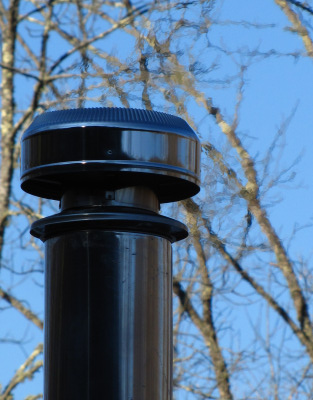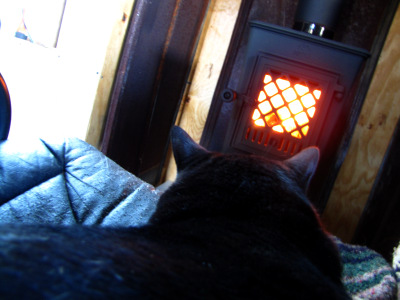
Efficient wood stove in action
 Take
a peek at the smoke coming out of our chimney while the Jotul
is operating nearly at full blast. Oh, you don't see
anything? I could hardly make out a hint of smoke either, just a
bit of a heat shimmering right around the rain cap. For the sake
of comparison, check out this
photo, which was
pretty typical of the huge plume of gray smoke exiting the chimney of
our exterior wood furnace.
Take
a peek at the smoke coming out of our chimney while the Jotul
is operating nearly at full blast. Oh, you don't see
anything? I could hardly make out a hint of smoke either, just a
bit of a heat shimmering right around the rain cap. For the sake
of comparison, check out this
photo, which was
pretty typical of the huge plume of gray smoke exiting the chimney of
our exterior wood furnace.
The Jotul's efficiency
isn't only obvious out the chimney, but also inside the firebox.
The one part of our tiny wood stove that I was leery of was the lack of
a tray for ashes. Wouldn't the little firebox just clog up after
an hour of burning and need to be cleaned out? Nope. After
our first four small and medium-sized fires, there was only about a
quarter of an inch of fluffy ash in the bottom of the stove --- not
even enough to bother scooping out. The instruction manual
suggests cleaning out the ashes every day or two, which sounds about
right.
By fire number three, I
could tell that the Jotul puts off a lot of heat. On a frosty
morning, fire number four heated up the trailer in no time, despite the
fact that I opened the back door to air out the scent of curing
paint. (As Roland mentioned and the  instruction
book for the stove reiterated, you need to be aware that a new stove
will probably stink like the dickens the first few times you light it
as the paint on the outside cures.) I figure we burned perhaps
two small logs in fire number four, which would have barely been enough
to push heat into the trailer with our exterior wood furnace but which
the princess used to warm up the whole front half of the trailer to
high room temperature. It sure is nice to be turning that wood
straight into heat instead of into smoke and ashes. As you can
see, even Huckleberry approves of our new space heating direction.
instruction
book for the stove reiterated, you need to be aware that a new stove
will probably stink like the dickens the first few times you light it
as the paint on the outside cures.) I figure we burned perhaps
two small logs in fire number four, which would have barely been enough
to push heat into the trailer with our exterior wood furnace but which
the princess used to warm up the whole front half of the trailer to
high room temperature. It sure is nice to be turning that wood
straight into heat instead of into smoke and ashes. As you can
see, even Huckleberry approves of our new space heating direction.
Want more in-depth information? Browse through our books.
Or explore more posts by date or by subject.
About us: Anna Hess and Mark Hamilton spent over a decade living self-sufficiently in the mountains of Virginia before moving north to start over from scratch in the foothills of Ohio. They've experimented with permaculture, no-till gardening, trailersteading, home-based microbusinesses and much more, writing about their adventures in both blogs and books.
Want to be notified when new comments are posted on this page? Click on the RSS button after you add a comment to subscribe to the comment feed, or simply check the box beside "email replies to me" while writing your comment.

Wow, that's a nice clean exhaust!
How well can you control the fire with the air intake? I'm curious if a fire would last overnight.
I've actually been doing a bit of experimenting along those exact lines. I filled the firebox all the way up around 9 last night and shut the air control nearly all the way down. Just before I went to sleep around 10 or so, I poked around and was able to fit in another small log. When I got up at 8, there were still a lot of hot coals in the bottom, though no active flames. I tossed on a couple of pieces of kindling and opened the air supply all the way up, and flames were licking up around the wood in no time. The literature says the stove will burn for 5 hours, which might be how long there is active flame in there?
I need to take a photo of the exhaust when the stove's damped down all the way --- I suspect I might see a bit of smoke then, but couldn't see last night since it was dark.
I've been extraordinarily happy, overall, with how easy it is to keep the trailer at the temperature I want. My experience in the past with wood stoves has been that you're either freezing or burning up, but by fitting the stove to our square footage, a hot fire is just right to keep the inside temperature at light long-sleeved shirt temperature during the chilly times of the day, and then we coast on coals over the warmer part of the day. Opening and closing the air intake has a reaction nearly as immediate as turning a light dimmer switch --- flames immediately decrease or increase, depending on what you're doing. But since hot fires burn more cleanly, I've just been adjusting the temperature by changing the amount of wood I put on the fire, which has been remarkably easy.
(I'm in love. Can you tell?)
I can already tell we're using a lot less wood. Mark is splitting it into smaller pieces, though, so I hope he's still putting in a lot less time. My vague feeling is that he spent maybe 15 minutes chopping this weekend, which has been keeping us warm since Thanksgiving, with a nice pile left to last through part of tomorrow.
The $300 worth of wood we bought, thinking of the beast, is starting to look like a two year supply....
I am new to this business and I just found out that lighting my Jotul filled my lounge with thick smoke from the vent.
I can't see what (if anything) I have done wrong, anyone know how to help?
We have a Vermont Castings wood stove that heated our house the first winter we lived in it, we still use it to supplement our heating system when the temperatures fall below -35C. We then installed a masonry heater/fireplace and have used it as the sole heat source ever since. We are in Canada, and winter temperatures can fall to -30C below zero for days at a time, and we still manage to keep our home reasonably warm. For most of the winter we only fire the heater two times a day, early morning and in the evening, 50 pounds of wood with the damper wide open. After the flames disappear we close the dampers and few hours later the heater begins to release heat. It is quite a commitment to install, but it paid for itself in the first five years.